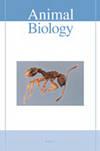Comparative genetic research on Microtus mystacinus (de Filippi, 1865) distributed in Asia and Europe inferred from mitochondrial (CYTB and COXI) and nuclear (IRBP) gene regions
IF 0.9
4区 生物学
Q2 ZOOLOGY
引用次数: 2
Abstract
The East European vole Microtus mystacinus is the most widespread vole species in Anatolia. It is also frequently seen in watery habitats in a large area of Eurasia. In this paper, an attempt was made to ascertain the level of genetic differentiation between Anatolian (Asian part of Turkey) and Turkish Thracian (European part of Turkey) populations together with additional data from other parts of Asia and Europe by analysing two mitochondrial (cytochrome-b and cytochrome oxidase subunit I) and one nuclear (interphotoreceptor retinoid binding protein) gene regions. Acquired Bayesian Inference trees mostly separated the Asian and European populations of M. mystacinus and the fixation index values implied a significant differentiation between these populations for mitochondrial DNA. On the other hand, the median-joining networks did not show diverging populations, significantly, and the mean genetic distance values among populations were found to be low for both mitochondrial and nuclear DNA. Evolutionary divergence times of Asian and European populations were also calculated and dated back to approximately 0.316–0.111 million years ago, coinciding with the ice ages of the Pleistocene epoch. According to the obtained results, M. mystacinus populations have not diverged enough to form different species; however, there is a separation between Asian and European populations which might result in speciation.从线粒体(CYTB和COXI)和核(IRBP)基因区推断分布于亚洲和欧洲的密迹鼠(Microtus mystacinus, de Filippi, 1865)的比较遗传学研究
东欧田鼠Microtus mystacinus是安纳托利亚分布最广的田鼠物种。它也经常出现在欧亚大陆大片水域的栖息地。在本文中,通过分析两个线粒体(细胞色素b和细胞色素氧化酶亚基I)和一个核(光受体间类视黄醇结合蛋白)基因区域,试图确定安纳托利亚人(土耳其的亚洲部分)和土耳其色雷斯人(土耳其的欧洲部分)种群之间的遗传分化水平,以及来自亚洲和欧洲其他地区的额外数据。获得的贝叶斯推断树主要分离了亚洲和欧洲密丝霉居群,固定指数值表明这些居群在线粒体DNA上存在显著差异。另一方面,中位连接网络没有显示出明显的种群分化,种群间的线粒体和核DNA的平均遗传距离值都很低。亚洲和欧洲种群的进化分化时间也被计算出来,可以追溯到大约0.316 - 0.11.1万年前,与更新世时期的冰河时代相吻合。根据所获得的结果,神秘支原体种群还没有分化到足以形成不同的物种;然而,亚洲和欧洲种群之间的分离可能导致物种形成。
本文章由计算机程序翻译,如有差异,请以英文原文为准。
求助全文
约1分钟内获得全文
求助全文
来源期刊

Animal Biology
生物-动物学
CiteScore
2.10
自引率
0.00%
发文量
34
审稿时长
3 months
期刊介绍:
Animal Biology publishes high quality papers and focuses on integration of the various disciplines within the broad field of zoology. These disciplines include behaviour, developmental biology, ecology, endocrinology, evolutionary biology, genomics, morphology, neurobiology, physiology, systematics and theoretical biology. Purely descriptive papers will not be considered for publication.
Animal Biology is the official journal of the Royal Dutch Zoological Society since its foundation in 1872. The journal was initially called Archives Néerlandaises de Zoologie, which was changed in 1952 to Netherlands Journal of Zoology, the current name was established in 2003.
 求助内容:
求助内容: 应助结果提醒方式:
应助结果提醒方式:


